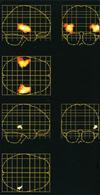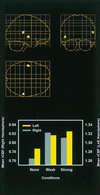Reactivation of encoding-related brain activity during memory retrieval
- PMID: 11005878
- PMCID: PMC27158
- DOI: 10.1073/pnas.97.20.11120
Reactivation of encoding-related brain activity during memory retrieval
Abstract
Neuronal models predict that retrieval of specific event information reactivates brain regions that were active during encoding of this information. Consistent with this prediction, this positron-emission tomography study showed that remembering that visual words had been paired with sounds at encoding activated some of the auditory brain regions that were engaged during encoding. After word-sound encoding, activation of auditory brain regions was also observed during visual word recognition when there was no demand to retrieve auditory information. Collectively, these observations suggest that information about the auditory components of multisensory event information is stored in auditory responsive cortex and reactivated at retrieval, in keeping with classical ideas about "redintegration, " that is, the power of part of an encoded stimulus complex to evoke the whole experience.
Figures



References
-
- Craik F I M, Tulving E. J Exp Psychol Gen. 1975;104:268–294.
-
- Morris C D, Bransford J D, Franks J J. J Verbal Learn Verbal Behav. 1977;16:519–533.
-
- Tulving E, Thomson D M. Psychol Rev. 1973;80:352–373.
-
- Ryan L, Eich E. In: Memory Consciousness and the Brain: The Tallinn Conference. Tulving E, editor. Philadelphia: Psychological; 1999. pp. 91–105.
-
- Godden D, Baddeley A D. Br J Psychol. 1975;66:325–331.
Publication types
MeSH terms
LinkOut - more resources
Full Text Sources
Medical

